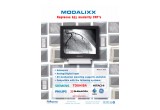
The latest medical virtual reality technology is here. See what makes this advancement so important as Ampronix describes the benefits.
Orange County, California, June 21, 2016 (Newswire.com) - The medical field has been slow to adopt the innovative frontier of virtual reality, which was conceptualized in the late 1980s. However, recent advancements in the accessibility of this immersive technology have led to its steady adoption by healthcare providers.
Developments in image quality, such as ultra-high definition 4K displays, as well as video gaming software, have paved the way for the election of virtual reality utilization within hospitals. Notably, Hoag Hospital and the Ronald Reagan UCLA Medical Center, have integrated Surgical Theater Surgical Planner (SRP) to their neurological surgery approach.
"It allows for increasingly minimally invasive procedures, which are much better for our patients because [there are] fewer complications, shorter hospital stays and overall faster recoveries and patient comfort"
Robert Louis, M.D, neurosurgeon and director of Hoag's Skull Base and Pituitary Tumor Program
As a combination of medical imaging procedures, gaming technology, and virtual reality, SRP is fundamentally changing how surgeons prepare for and accomplish surgical procedures. It works by translating CT and MRI scans into interactive 3D models with life-like tissues that can react to digital surgery tools. Since the simulation is based on actual medical images of the patient undergoing surgery, surgeons can virtually perform the procedure and plan ahead to avoid issues that were previously unforeseeable.
The 3D virtual reality system has benefited these healthcare providers via its simulation capabilities and detailed brain map functionality. “It allows for increasingly minimally invasive procedures, which are much better for our patients because [there are] fewer complications, shorter hospital stays and overall faster recoveries and patient comfort,” said Robert Louis, M.D, neurosurgeon and director of Hoag’s Skull Base and Pituitary Tumor Program.
However, virtual reality in the medical field is not strictly used for surgical applications. For instance, tele-health—a method of clinical diagnosis and monitoring—is an ubiquitous way in which virtual reality can utilize four key facets of healthcare delivery: video conferencing, store and forward, remote patient monitoring, and mobile health.
This particular application of augmented reality has transformed intercommunication between patients and physicians; liberating patients to seek specialized care—regardless of distance—while simultaneously facilitating open communication for physicians. In addition, remote patient monitoring and mobile health have placed the impetus on patients to consistently maintain and monitor their care.
Tele-health exists in a multitude of iterations that urge patients to incorporate virtual reality in their treatment processes. With their pioneering Virtual Care Clinic System, USC Center for Body Computing is at the forefront of making augmented reality more user-friendly for patients. Spearheaded by Dr. Leslie Saxon, the program allows patients to receive medical care from their mobile device for easy accessibility and convenience. Saxon’s likeness is digitally rendered to give patients the impression of receiving advice from a trusted professional.
At the Institute for Creative Technologies at USC, physicians are utilizing virtual reality as a tool to help individuals with PTSD and anxiety disorders confront their psychological inhibitions. With the employment of Bravemind, a clinical and interactive virtual reality exposure therapy tool, physicians can configure reenactments of trauma inducing scenarios. Through recreation of these anxiogenic experiences, patients are able to reimmerse themselves in past pivotal events and reassociate the corresponding emotions, an instrumental step in the healing process.
Although these applications for virtual reality are changing the nature of how medical care is delivered, wholescale adoption will remain a slow process, until the cost of these systems are reappraised. For instance, the previously cited Surgical Theater system’s price point is upwards towards half a million dollars. Some argue that these systems will save money over time due to the services they provide; however, the initial cost is a great deterrence in acquiring this advanced technology. Nonetheless, virtual reality in the healthcare system has proven beneficial for both patients and physicians alike.
Contact Ampronix:
Media Contact: Jamie Nguyen
Email: info@ampronix.com
International Sales: +1 949-273-8000
Domestic Sales: 1800-400-7972 for US and Canada
Follow Us:
View our Product Catalog Online Here
About Ampronix
Ampronix is a renowned authorized master distributor of the medical industry's top brands as well as a world class manufacturer of innovative technology. Since 1982, Ampronix has been dedicated to meeting the growing needs of the medical community with its extensive product knowledge, outstanding service, and state-of-the-art repair facility. Ampronix prides itself on its ability to offer tailored, one-stop solutions at a faster and more cost effective rate than other manufacturers. Ampronix is ISO 13485:2003, ISO 9001:2008, and ANSI/ESD S20.20-2007 certified.
Source: www.Ampronix.com
Share:




